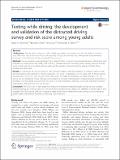| dc.contributor.author | Bergmark, Regan W. | en_US |
| dc.contributor.author | Gliklich, Emily | en_US |
| dc.contributor.author | Guo, Rong | en_US |
| dc.contributor.author | Gliklich, Richard E. | en_US |
| dc.date.accessioned | 2016-04-01T15:48:03Z | |
| dc.date.issued | 2016 | en_US |
| dc.identifier.citation | Bergmark, Regan W., Emily Gliklich, Rong Guo, and Richard E. Gliklich. 2016. “Texting while driving: the development and validation of the distracted driving survey and risk score among young adults.” Injury Epidemiology 3 (1): 7. doi:10.1186/s40621-016-0073-8. http://dx.doi.org/10.1186/s40621-016-0073-8. | en |
| dc.identifier.issn | 2197-1714 | en |
| dc.identifier.uri | http://nrs.harvard.edu/urn-3:HUL.InstRepos:26318632 | |
| dc.description.abstract | Background: Texting while driving and other cell-phone reading and writing activities are high-risk activities associated with motor vehicle collisions and mortality. This paper describes the development and preliminary evaluation of the Distracted Driving Survey (DDS) and score. Methods: Survey questions were developed by a research team using semi-structured interviews, pilot-tested, and evaluated in young drivers for validity and reliability. Questions focused on texting while driving and use of email, social media, and maps on cellular phones with specific questions about the driving speeds at which these activities are performed. Results: In 228 drivers 18–24 years old, the DDS showed excellent internal consistency (Cronbach’s alpha = 0.93) and correlations with reported 12-month crash rates. The score is reported on a 0–44 scale with 44 being highest risk behaviors. For every 1 unit increase of the DDS score, the odds of reporting a car crash increases 7 %. The survey can be completed in two minutes, or less than five minutes if demographic and background information is included. Text messaging was common; 59.2 and 71.5 % of respondents said they wrote and read text messages, respectively, while driving in the last 30 days. Conclusion: The DDS is an 11-item scale that measures cell phone-related distracted driving risk and includes reading/viewing and writing subscores. The scale demonstrated strong validity and reliability in drivers age 24 and younger. The DDS may be useful for measuring rates of cell-phone related distracted driving and for evaluating public health interventions focused on reducing such behaviors. | en |
| dc.language.iso | en_US | en |
| dc.publisher | Springer International Publishing | en |
| dc.relation.isversionof | doi:10.1186/s40621-016-0073-8 | en |
| dc.relation.hasversion | http://www.ncbi.nlm.nih.gov/pmc/articles/PMC4771824/pdf/ | en |
| dash.license | LAA | en_US |
| dc.title | Texting while driving: the development and validation of the distracted driving survey and risk score among young adults | en |
| dc.type | Journal Article | en_US |
| dc.description.version | Version of Record | en |
| dc.relation.journal | Injury Epidemiology | en |
| dash.depositing.author | Bergmark, Regan W. | en_US |
| dc.date.available | 2016-04-01T15:48:03Z | |
| dc.identifier.doi | 10.1186/s40621-016-0073-8 | * |
| dash.authorsordered | false | |
| dash.contributor.affiliated | Gliklich, Richard | |
| dash.contributor.affiliated | Bergmark, Regan | |


